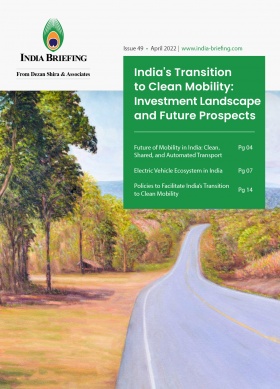Highlights of the Indian Economic Survey 2022-23
The Indian Economic Survey 2023 provides growth projections for the current financial year (FY23) and commentary on growth prospects for the upcoming financial year (FY24). It evaluates India’s consumption patterns and inflation trajectory.
Below we discuss the key takeaways.
State of Indian economy
As per the economic survey 2022-23, India’s real gross domestic product (GDP) growth is expected to remain robust in FY23 at seven percent. Further, the country should register GDP growth in the range of 6-6.8 percent in FY24, depending on global headwinds.
The Economic Survey projects a baseline GDP growth of 6.5 percent in real terms and 11 percent in nominal terms in FY24. The survey states: “despite strong global headwinds and tighter domestic monetary policy, a robust growth forecast for India in the range of 6.5 to seven percent is a reflection of India’s underlying economic resilience; of its ability to recoup, renew and re-energize the growth drivers of the economy.”
|
India’s Economic Growth Remains Resilient |
|||
|
|
Real GDP (INR trillion) |
YoY growth (in percent) |
FY20 level (INR trillion) |
|
FY20 (2nd Revised Estimate (RE)) |
145 |
3.7 |
145 |
|
FY21 (1st Revised Estimate (RE)) |
136 |
-6.6 |
145 |
|
FY22 (Previous Estimate (PE)) |
147 |
8.7 |
145 |
|
FY23 (1st Advanced Estimate (AE)) |
158 |
7.0 |
145 |
Growth in credit lending to the MSME sector (medium, small, and micro enterprises) has been the responsible for boosting growth. During the period between January to November 2022, credit lending to MSMEs averaged 30.5 percent.

In addition, the federal government’s capital expenditure rose by 63.4 percent in the first eight months of FY23, contributing to an expansion of the Indian economy. Going by the capex multiplier estimated for the country, the economic output of the country is set to increase by at least four times the amount of the capital spending.

Broad-based growth driven by demand and investment
India’s consumption impressively recovered in 2022 and pulled up domestic capacity utilization. The Motilal Oswal Economic Activity Index for November 2022 shows that domestic private consumption remains buoyant. The index predicts that private consumption increased at a pace of 5.6 percent y-o-y, a five-month high, propelled by auto sales and a broad expansion of services.
Private consumption as a percentage of GDP stood at 58.4 per cent in Q2 of FY23, the highest among the second quarters of all the years since 2013-14, supported by a rebound in contact-intensive services, such as trade, hotel, and transport. According to the survey, this increase in consumption has been aided by the release of “pent-up” demand. While this phenomenon is not exclusive to India, it does show a local pattern that is impacted by an increase in the consumption share of disposable income. In India, where consumption makes up a large portion of disposable income, a pandemic-induced reduction in consumption built up an even stronger recoil effect. Consequently, the consumption rebound can be long-lasting. In India, personal loan growth is accelerating, which attests to a persistent discharge of pent-up consumer demand.
The Reserve Bank of India’s (RBI) most recent survey of consumer confidence released in December 2022 pointed to improving sentiment with respect to current and prospective employment and income conditions.

Industry and service sectors leading India’s growth
India has a sizable population to support and grow thriving industrial and service industries. The manufacturing sector has the potential to produce employment, attract foreign capital, and contribute to external stability by engaging in low- to high-value-added activities with export potential.
Indian industry is on the verge of a growth resurgence, made possible by public investment and enabling policies that have increased viability and lowered barriers to doing business. Bank lending to business has increased, especially to micro, small, and medium-sized firms.
|
YoY growth of Real Gross Value Added (GVA) Components |
|||
|
|
Agriculture and allied activities |
Industry |
Services |
|
FY19 (3rd RE) |
2.1 |
5.3 |
7.2 |
|
FY20 (2nd RE) |
5.5 |
-1.4 |
6.3 |
|
FY21 (1st RE) |
3.3 |
-3.3 |
-7.8 |
|
FY22 (PE) |
3.0 |
10.3 |
8.4 |
|
FY23 (1st AE) |
3.5 |
4.1 |
9.1 |
Along with other factors, the pandemic has changed perspectives on supply chains, moving them from efficiency to security and from “just in time” to “just in case.” But now that the pandemic’s effects are waning, the reconfiguration of global supply chains is underway. The Indian government sees a significant opportunity here, and it is clear from its commitment to the Production Linked Incentive (PLI) Scheme that it is determined to connect India to international supply chains.
Moreover, India now also has the necessary physical and technological infrastructure to increase the manufacturing sector’s share of the economy and realistically compete for a key position in global value chains.
Foreign direct investment (FDI) into India has been consistent, and investors are now visibly more interested in including India into their supply chain diversification plans. In the coming years, increasing India’s cost- and export-competitiveness is anticipated to be major goals for PM Gati Shakti and the National Logistics Policy.
Moreover, with an estimated investment of approximately INR 111 trillion for the years FY20 – FY25, the National Infrastructure Pipeline was established with the goal of developing comprehensive infrastructural network in India. In the last eight years, ports and airports have undergone significant improvement, and there has been an unparalleled growth of roads, railways, and waterways.
India’s inflation rate in FY23
The RBI forecasts FY23 headline inflation at 6.8 percent. Consumer demand in India is reportedly being constrained by high inflation. The survey did, however, sound optimistic about the inflation rate and trajectory, noting that “it is not high enough to discourage private spending and also not so low as to impair the inducement to invest.”
As per the survey, there was a respite for governments and households in the second half of 2022 when the commodity prices first peaked and then declined. Although some commodities’ prices (such as crude oil) are still significantly higher than they were before the pandemic, the acute pressure was temporarily lifted.
In order to prevent second-round consequences of the inflation shock of commodities from impeding economic activity, the RBI hiked interest rates throughout the year. That was among major factors enabling the Indian rupee’s relative stability versus the US dollar in a year of dollar strength.


About Us
India Briefing is produced by Dezan Shira & Associates. The firm assists foreign investors throughout Asia from offices across the world, including in Delhi and Mumbai. Readers may write to india@dezshira.com for more support on doing business in in India.
We also maintain offices or have alliance partners assisting foreign investors in Indonesia, Singapore, Vietnam, Philippines, Malaysia, Thailand, Italy, Germany, and the United States, in addition to practices in Bangladesh and Russia.
- Previous Article India’s Union Budget for 2023-24: Key Highlights
- Next Article India’s G20 Presidency and Asian Trade Implications











